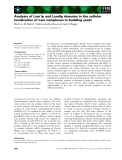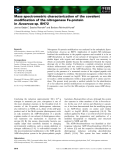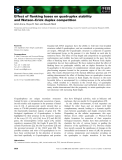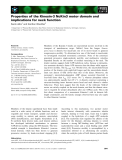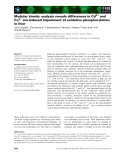
Comparative study of degumming of silk varieties by different techniques
Shweta K. Vyas and Sanjeev R. Shukla*
Department of Fibres & Textile Processing Technology, Institute of Chemical Technology (University under Section 3 of UGC Act
1956), Mumbai, India
(Received 15 September 2014; accepted 26 January 2015)
Different varieties of silk differ from each other in their chemical composition as well as the physical, chemical and
mechanical properties. Silk degumming is a primary important process, which needs to be carried out uniformly to a
sufficient level to get good quality in further processes such as dyeing. In the present study, we have compared the
efficiencies of five different degumming treatments for eri, tasar and mulberry silk fabrics using conventional, ultrasonic
and microwave techniques. Among the various treatments, soda ash plus hydrogen peroxide and enzyme (papain)
degumming recipies gave the best results in terms of weight loss and absorbency. As compared to the conventional
technique, the treatments under ultrasonication and microwave enhanced the efficiency. The microwave technique was
found to be superior, with the advantage of drastic reduction in treatment time, better retention of tensile strength and
smooth appearance of silk. The dye uptake also increased after degumming. The molecular conformation of the different
silk varieties, as estimated by FTIR spectroscopy, and the crystalline structure, as elucidated by X-ray diffraction,
remained unchanged. SEM showed distinct morphological changes on degumming.
Keywords: silk varieties; degumming processes; ultrasonication; microwave; FTIR; XRD; SEM
Introduction
Silk is a unique natural protein filament fibre produced
by sericigenous insects. It is one of the world’s most
exclusive and luxurious fibres. Silk is categorized into
mulberry or domesticated silk and non-mulberry or wild
silk like muga, eri and tasar. Eri silk, also known as
‘Ahimsa Silk’in India and produced by the worm
Philosamia ricini, is a secretion of a lepidopteran insect
Samia ricini and it is available in the north-east region
of India, particularly Assam. Tasar silk is produced by
the worm Antheraea mylitta, whereas mulberry silk is
produced by the worm Bombyx Mori and it is available
in Andhra Pradesh, Karnataka, Tamil Nadu and West
Bengal (Kariyappa, 2008). Although labelled as ‘silk’,
their characteristic properties differ widely, and hence a
comparison of their processing is necessary for obtaining
desired optimum performance.
The silk fibre is composed of two cores of fibroin
surrounded by a layer of sericin in a structure known as
a bave (each individual fibroin core is known as a brin)
(Pérez-Rigueiro, Viney, Lorca, & Elices, 2000). Fibroin
is the structural protein of silk fibre, whereas sericin is
the water-soluble proteinaceous glue that serves to bond
the fibres together. The majority of fibroin’s composition
contains amino acids with bulkier side chains. The
sericin content of mulberry is 20–30%, tasar of 7–15%
and that of eri silk is as low as 7–12%, since most of it
gets removed during the cooking of cocoons (Srisuwan,
Narkkong, & Srihanam, 2009). The composition of the
fibroin is glycine, alanine and serine; and that of sericin
is serine, aspartic acid and glycine, with threonine
present in significant amounts.
Degumming and bleaching are the important
treatments of silk processing. The presence of gum
sericin makes the silk harsh and stiff, and masks its
natural lustre. Degumming is a process of cleavage of
peptide bonds of sericin by hydrolysis or enzyme action
(Chopra, Chattopadhyay, & Gulrajani, 1996). The
recommended standard method of degumming is based
on Marseilles soap, which is prepared from olive oil.
However, degumming of silk has been carried out
conventionally by soap–soda ash method and it is
considered the best, although it has the drawback of
some fibre degradation leading to dull appearance and
loss in tensile strength. Furthermore, studies have been
reported on the removal of sericin by different types of
enzymes (Freddi, Mossotti, & Innocenti, 2003; Gulrajani,
Gupta, Gupta, & Suri, 1996). Organic acids have been
attempted as alternative agents due to their milder action
to overcome the problems present in traditional
degumming process. Degumming of silk fabric with
tartaric acid showed excellent performance, in terms of
silk sericin-removal efficiency (Freddi, Allara, &
Candiani, 1996; Khan et al., 2010).
The work reported here aims to compare the
efficiencies of degumming, bleaching and dyeing
*Corresponding author. Email: srshukla19@gmail.com
© 2015 The Textile Institute
The Journal of The Textile Institute, 2015
http://dx.doi.org/10.1080/00405000.2015.1020670
Downloaded by [Florida Atlantic University] at 00:52 10 September 2015





















